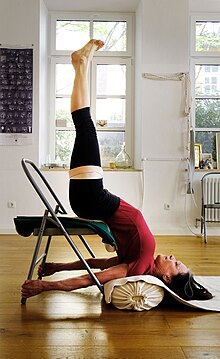Iyengar yoga
Iyengar yoga is a yoga direction that was developed by BKS Iyengar and is attributed to Hatha yoga . In the course of his decades of practice, he researched every single yoga posture ( asana ) with regard to its correct alignment and effect. The experiences he made with his own body led Iyengar to use or develop new tools, so-called "props", such as non-slip mats, belts, blocks, cushions, back benches. These aids should make the demanding yoga exercises easier, especially for people from the West.
The following are typical of Iyengar yoga:
- The exact alignment of the body in the yoga posture
- Coordinated exercises
- The use of resources
- Lingering in the exercise for a certain period of time
The apprenticeship training at Iyengar Deutschland eV comprises 1000 teaching units in which Asana and Pranayama , yoga philosophy , anatomy and physiology and professional studies are taught.
Web links
Individual evidence
- ^ A b Lawrence Kowalski: BKS Iyengar | Indian teacher. In: Enyclopaedia Britannica. Retrieved April 9, 2020 .
- ^ Iyengar Yoga Institute Frankfurt - About us. In: iyengar-yoga-institut.de. Iyengar® Yoga Institute Frankfurt am Main, accessed on April 9, 2020 .
- ^ Teacher training - Iyengar-Yoga Deutschland eV In: Iyengar-Yoga Deutschland eV Accessed on April 9, 2020 .
